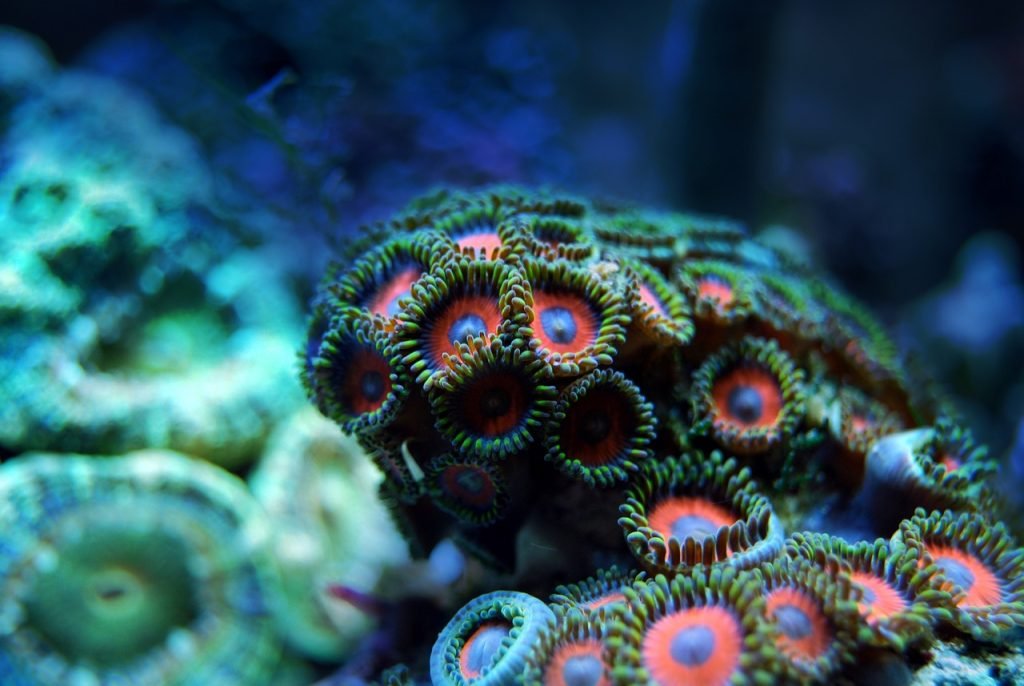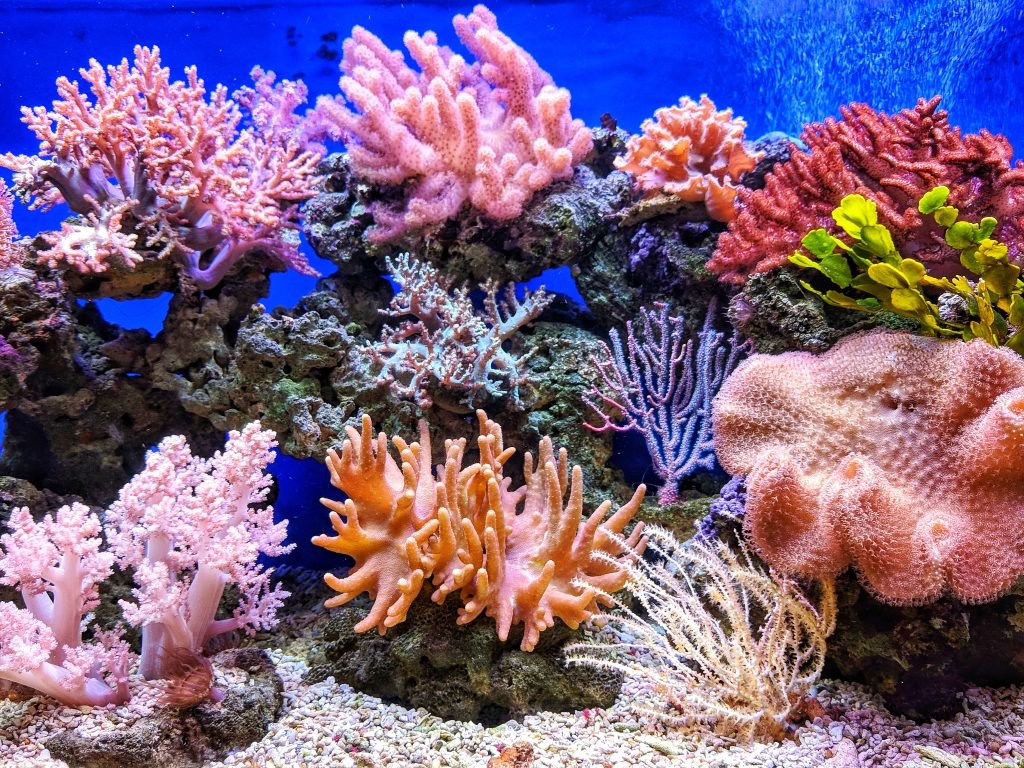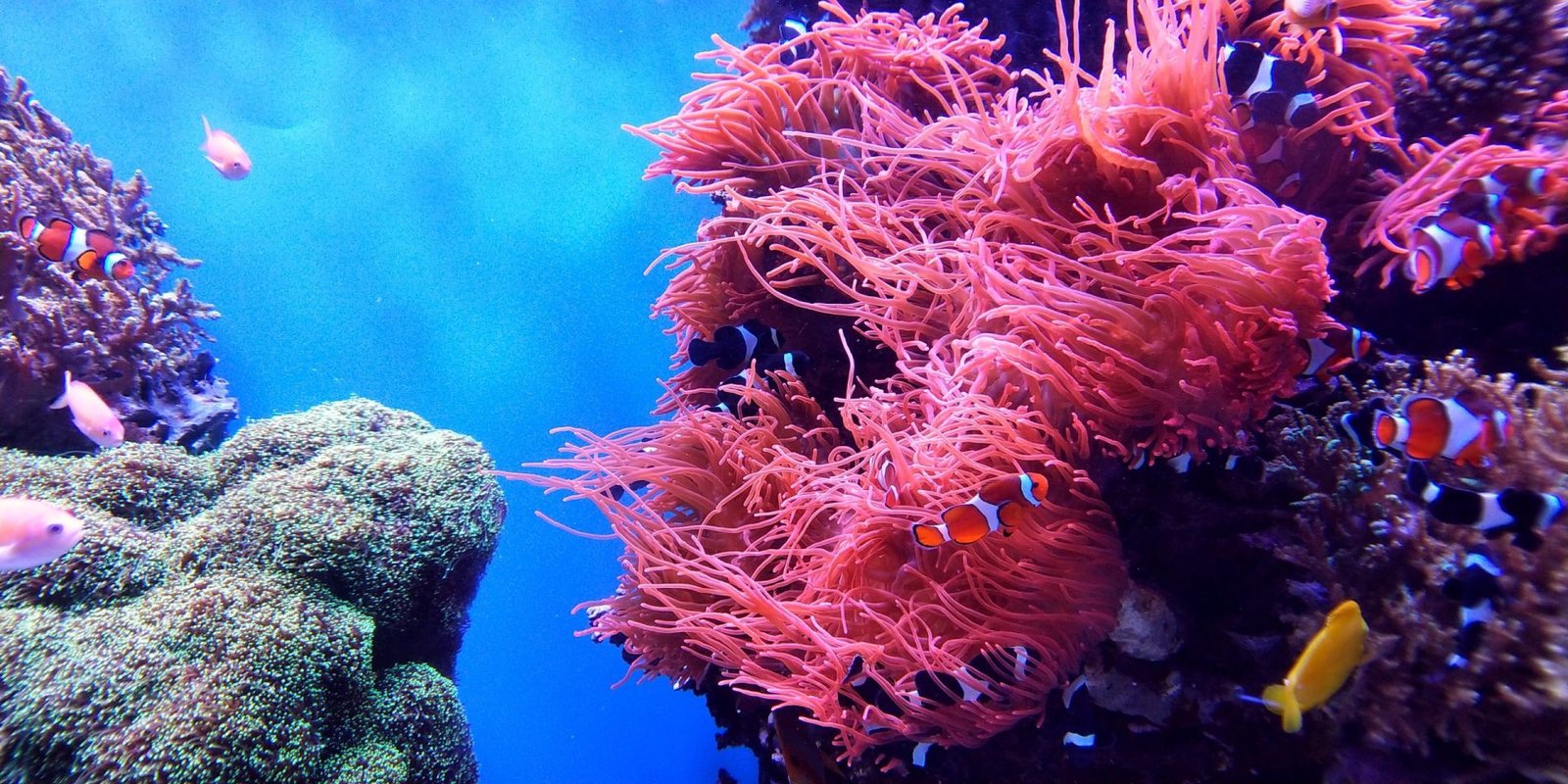Coral is a type of organism that has fascinated biologists for centuries due to its fascinating reproduction cycle and the role it plays in sustaining oceanic ecosystems.
Generally, coral reproduces by a process of sexual reproduction involving both male and female gametes, although asexual reproduction can also occur.
But what is less well known is whether or not coral actually lay eggs. While some species of coral, like certain types of anemones, lay eggs as part of their reproduction process, the majority of corals do not. Instead, they typically spawn, or release their sperm and egg bundles into the water, where fertilization then takes place.
All About Coral Reef Eggs and Coral Spawning
Coral reef egg and coral spawning is the process of mass spawning of coral larvae that take place periodically. This occurs as a reproductive event where coral eggs are released by adult corals into the ocean to form coral larvae, which will then settle and form new coral reefs.
During spawning, vast amounts of coral eggs and larvae are released simultaneously by colonies of coral and become the foundation for new coral reef formations. The events occur mainly in the warmer months, during full moons and higher than average water temperatures.
What exactly is Coral?
Coral is an aquatic organism that forms part of the diverse family of cnidarians. It is made up of numerous colonies of polyps, which can exist both in salt water and fresh water environments. Each polyp secretes a stony, calcium carbonate external skeleton which serves as a shelter and home to the coral.
The colour of coral varies depending on its environment and type of polyps, but most typically appear in hues of pinks, reds, blues and purples.
Corals feed mainly on plankton, however they also benefit from zooxanthellae – an algae which live in their tissues and gives them the ability to photosynthesise and increase the coral’s overall growth rate.
What is a Coral Egg?
Coral eggs, also known as coral spawn, are jelly-like masses released by corals during a specific season and time of the year, usually in late summer or fall. They contain thousands of individual eggs from a single coral colony and resemble egg whites.
Once released into the ocean, larvae emerge from the coral eggs and disperse by floating in the current, in the hopes of settling nearby and growing into a new coral colony in its earliest form, known as a polyp.
Do Coral Reefs have eggs?
Yeah In a way you can say that Coral reefs have eggs. Coral reefs are unique ecosystems and while they do not lay eggs, their spawn often take the form of microscopic egg-shaped particles known as gametes.
When male and female coral spawn in synchrony with the lunar cycle, they can release as many as billions of gametes, with some coral species spawning simultaneously across large stretches of the reef.
Spawning typically occurs during summer months when the water temperature is high, allowing the coral to broadcast their eggs and sperm further away, increasing the chances of fertilization.
Corals and Coral Reefs – All You Need To Know
Introduction
Let’s understand more. Coral reefs are some of the most diverse ecosystems on Earth. They provide a home for thousands of species, provide important protection against coastal storms and other weather-related events, and act as natural habitats for important fish species.
Unfortunately, due to various environmental factors, the number of coral reefs worldwide is declining, threatening the health and longevity of marine life. In this article, we will explore what corals are, why coral reefs are important, and what can be done to protect them.

What Are Corals?
Corals are organisms that live in tropical and subtropical ocean waters. They are composed of a combination of calcium carbonate and proteins secreted by living coral animals called polyps. They can form reefs or even single, solitary structures called coral heads.
Corals can also reproduce asexually by breaking into small fragments, called “daughter colonies”, or through budding. The size, shape and color of a coral are dependent on the species and environmental conditions.
The Importance of Coral Reefs
Coral reefs are vital to the survival of ocean ecosystems, providing food and habitat for thousands of species. They protect shorelines from wave and storm damage, stabilize sediments and shorelines, and serve as spawning grounds for many fish species.
Additionally, coral reefs are a vital source of biodiversity and an essential part of the global marine food web. Coral reefs are also important economically, providing fishing grounds, recreation and tourism.
Threats to Corals
Unfortunately, coral reefs around the world are being threatened by a number of human-related activities. Rising sea surface temperatures, acidification, overfishing, and pollution are just some of the factors contributing to the deterioration of coral reefs.
Other natural disasters, such as cyclones, coral bleaching, and diseases, also contribute to the degradation of coral reefs.
How Can We Help Protect Corals?
The health of coral reefs is dependent on the actions we take. We can all help by practicing responsible tourism and refraining from buying products made from coral.
We should also reduce our energy consumption to minimize our contribution to global warming, limit fishing and marine debris, and become more educated about the ocean and our impact on it.
Additionally, there are many conservation efforts taking place worldwide that are aimed at protecting coral reefs and other important ecosystems.
How many eggs does a Coral release?
Witnessing a coral spawning event can be an awe-inspiring experience, as corals can release anywhere from several hundred to several hundred thousand eggs at once. Although the exact amount depends on the species and environmental conditions, these huge spawning events are essential for corals to thrive and reproduce, preserving their species in their delicate environment.
What is Coral Spawning?
Coral spawning is the reproductive process in which corals release their eggs and sperm into the water. This usually occurs once a year and is synchronized with the lunar cycle or tidal patterns.
During this event, the corals release a huge number of eggs and sperm, creating a massive cloud of gametes that mixes in the water. This increases the chances of fertilization and the development of new coral colonies.
Coral spawning is an important aspect of coral biology and plays a crucial role in maintaining the health and diversity of coral reefs.
What is baby Coral called?
It’s called Coral Larvae. When eggs and sperm are fertilized during coral spawning, a coral larva is produced. After hatching, this larva drifts along with the ocean currents until settling onto a suitable substrate, where it will transform into a juvenile coral polyp.
Through continued growth, this single polyp will eventually form an entire coral colony, providing a home for marine creatures and helping to establish and maintain coral reefs.
Are Corals male or female?
It’s amazing that Corals are both male and female. Corals are hermaphroditic, meaning they have both male and female reproductive organs. During coral spawning, a coral can release both eggs and sperm, allowing for self-fertilization or cross-fertilization with other corals.
This increases the chances of successful reproduction and helps to maintain the diversity and health of coral populations. However, some corals are also capable of changing sex over the course of their lives, depending on environmental conditions and the availability of mates.

How do Coral reproduce sexually or asexually?
Corals can reproduce both sexually and asexually.
Sexually, corals reproduce through coral spawning, a process in which they release eggs and sperm into the water. The eggs and sperm mix and fertilize, producing coral larvae that eventually settle onto a suitable substrate and transform into juvenile coral polyps.
This is the primary method of reproduction for most coral species and helps to maintain the genetic diversity of coral populations.
Asexually, corals can reproduce by budding, fragmentation, or by releasing coral planulae, which are tiny, motile versions of coral larvae. In budding, a new coral polyp grows from a parent polyp and becomes physically separated from it. In fragmentation, a piece of a coral colony breaks off and grows into a new colony.
Both of these asexual reproduction methods allow corals to rapidly colonize new areas or create new colonies in response to environmental changes.
Overall, both sexual and asexual reproduction are important for the survival and growth of coral populations and play a crucial role in maintaining the health and diversity of coral reefs.
How do you get Coral to spawn?
Coral spawning is a natural process that occurs once a year, typically synchronized with the lunar cycle or tidal patterns. While it is a naturally occurring event, there are certain conditions that can influence the timing and success of coral spawning. Some of the factors that can affect coral spawning include:
Water temperature: Corals tend to spawn when water temperatures reach a certain level, usually near the warmest time of the year.
Light: Corals are sensitive to changes in light, and they often spawn in response to a sudden increase in light intensity, such as a full moon or bright artificial light.
Nutrient levels: Higher levels of nutrients in the water can trigger coral spawning.
Chemical cues: Certain chemical cues, such as the release of pheromones or other substances by other corals, can trigger coral spawning.
While it is difficult to control the exact timing and success of coral spawning, researchers and aquarists can manipulate the conditions in coral reefs and aquariums to encourage coral spawning. This can be done by controlling water temperature, light levels, nutrient levels, and the presence of other chemical cues.
It’s important to note that coral spawning is a delicate and complex process, and it’s essential to understand the biology and behavior of individual coral species in order to successfully encourage coral spawning.
When does Coral spawning occur?
Coral spawning typically occurs annually, usually at night and during a full moon phase in the warmer months, between late spring and early fall, depending on the species and location.
What triggers Coral spawning?
Coral spawning is triggered by a combination of environmental factors, including water temperature, lunar cycle, and seasonal changes. Some species of corals also respond to changes in water chemistry and light levels.
These environmental cues signal to the coral that it’s time to reproduce and release their eggs and sperm into the water column for fertilization.
How do Corals know when to spawn?
Corals know when to spawn based on a combination of environmental cues, such as changes in water temperature, light, and lunar cycles.
The exact trigger varies among species and locations, but coral reefs worldwide typically synchronize their spawning to increase the likelihood of successful fertilization and recruitment of the next generation.
What does Coral spawning look like?
Coral spawning is the simultaneous release of gametes (eggs and sperm) into the water column by coral colonies. The event typically takes place at night and can be visually stunning, with the water appearing to be clouded by clouds of colorful, milky-white, or pinkish-white mucus-filled gametes.
The synchronized release of gametes can occur over the entire reef or just by a single coral species and can involve hundreds to thousands of coral colonies at once. It is a crucial aspect of coral reproduction and contributes to the replenishment and diversity of coral reefs.
How often do Coral reproduce?
Coral species can reproduce either sexually or asexually. Sexual reproduction usually occurs once a year, usually during the full moon phase in a process known as “coral spawning”. Asexual reproduction can occur more frequently and can happen through fragmentation or budding.
How do Coral make babies?
Coral can reproduce both sexually and asexually. In sexual reproduction, coral release eggs and sperm into the water during annual mass spawning events. If the eggs are fertilized and survive, they will develop into larval coral that can settle and grow into new colonies.
Asexual reproduction, on the other hand, can occur when a piece of a coral breaks off and grows into a new individual, or when a coral polyp splits into two.
What type of symbiotic relationship is Coral?
Coral and photosynthetic algae known as zooxanthellae have a symbiotic relationship where both parties benefit. The coral offers a secure habitat to the algae and the algae supply the coral with essential nutrients through photosynthesis. This is a mutualistic relationship.
What are parasitic relationships in the Coral reef?
Parasitism is a type of symbiotic relationship in which one organism, the parasite, benefits at the expense of the other organism, the host. In coral reef ecosystems, several species of organisms engage in parasitic relationships. Some examples include:
-Sea anemones that attach to the shells of hermit crabs and feed on their leftovers.
-Pea crabs that live inside mollusk shells and feed on their food and waste.
-Coral-feeding polychaete worms that attach to coral and feed on their mucus and tissue.
These relationships play a role in shaping the diversity and dynamics of coral reef ecosystems.
What are Coral larvae?
Coral larvae are baby corals that are produced by the eggs of adult coral. The larvae drift and feed on microscopic organisms in the ocean until they settle on a hard substrate, usually a rock or other coral. Once settled, the coral larvae then start to grow, often attaching to nearby coral to form larger structures.
The health and diversity of coral reefs are heavily dependent on the availability of healthy coral larvae and their ability to settle on the seafloor and mature into adult colonies.
Corals lifecycle
Corals are living organisms, and their lifecycle starts as single cells which replicate asexually. They form coral polyps which attach themselves to solid substrates and develop into colonies, providing shelter and nutrition for many ocean creatures.
As the coral colonies mature, they also reproduce sexually, releasing eggs and sperm into the water, where fertilization takes place. These fertilized eggs eventually hatch, producing coral larvae which settle onto substrates and grow, repeating the cycle.
While these stages usually last for a couple of months, the full life cycle of coral colonies can take many years. As such, protecting and preserving coral reefs is a very important part of ensuring a healthy ocean environment.
Are Corals fissions?
No, corals are not fissions. Corals are invertebrate marine animals, belonging to the class Anthozoa of the phylum Cnidaria.
These animals secrete calcium carbonate, forming the hard skeletons that make up coral reefs. In some cases, corals may reproduce through fission, but in most cases, they reproduce by releasing eggs and sperm into the water column.
Fission is a type of asexual reproduction in which an organism splits in half and produces two genetically identical organisms.
How do Corals feed?
Corals are animals that feed primarily on tiny floating creatures such as zooplankton. Corals have evolved a specialized set of tentacles which they use to capture food as it floats by in the current. In addition, they can absorb dissolved organic matter and plankton directly from the water.
As they extend their tentacles they collect small crustaceans and other microorganisms from the water. This nutritious food is then sent down to their mouth and the leftovers are ejected through their mouths.
To get additional nutrition, corals have developed a symbiotic relationship with zooxanthellae algae, which reside in their cells.
The zooxanthellae receive the products of photosynthesis from the coral’s tentacles in exchange for essential sugars, nitrogen and phosphorus, produced through photosynthesis. This enables corals to thrive in nutrient-poor waters and helps to build the coral reef ecosystems.
Does Coral eat algae?
Coral and algae have a mutually beneficial relationship known as “symbiosis”. Corals consume nutrients such as nitrogen and phosphorus released by algae, and the coral provide shelter for the algae and the algae help provide oxygen and other vital nutrients for the coral.
As such, one might think that coral would eat algae, however this is not the case. In fact, corals mainly get their nutrients from zooxanthellae, a single-celled photosynthetic organism that lives within the coral, and from prey items such as small fish, plankton, and other organic matter that floats in the water.
Do corals eat zooplankton?
Corals do not directly consume zooplankton. Instead, they filter feed by capturing phytoplankton and other microscopic particles from the water column with their tentacle-like cilia, and absorb these particles through their tissues.
While some corals also possess additional strategies for acquiring food, such as trap and kill mechanisms and direct uptake of nutrients, the majority of their nutrition is acquired through the filter feeding process.
Zooplankton may end up within the coral’s filter feeding “net”, providing the coral with a nutrient-rich supplement to its normal diet of phytoplankton.
Final Words
In conclusion, corals lay eggs as part of their reproductive cycle, which helps them survive and pass on genetic information. Coral eggs vary in color and size, and come in both spawned and brooded varieties. They also contain essential proteins and nutrients, helping to keep coral colonies strong. With all these unique and fascinating characteristics, coral eggs are an important part of the ocean ecosystem.
Recent Posts
What Does Kiviak and Its Eggs Really Taste Like and How Do You Even Eat It?
Kiviak and its eggs taste like fermented blue cheese mixed with oily game meat, wrapped in a punch of ammonia. This dish, found in Greenland, is made by stuffing hundreds of whole auk birds into a...
Are Ethical Concerns in Egg and Chicken Farming Being Ignored?
Egg and chicken farming has raised significant ethical concerns, affecting both the animals involved and the consumers who rely on these products. The conditions in which chickens are raised, their...

